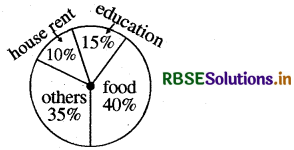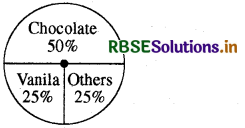RBSE Class 8 Maths Important Questions Chapter 5 Data Handling
Rajasthan Board RBSE Class 8 Maths Important Questions Chapter 5 Data Handling Important Questions and Answers.
RBSE Class 8 Maths Chapter 5 Important Questions Data Handling
Multiple Choice Questions
Question 1.
Why do we organise the data in a systematic manner?
(a) for feautification
(b) for tabulation
(c) for meaningful result
(d) none of these
Answer:
(c) for meaningful result
Question 2
Which of the tally marks represents the number 5?
(a) ||||
(b) 
(c) 
(d) 
Answer:
(d) 

Question 3.
The complete angle at the centre of the circle measures
(a) 90°
(b) 360°
(c) 180°
(d) 100°
Answer:
(b) 360°
Question 4.
This pie chart shows household expenditure broken down into categories. For which category, expenditure incurred is the most?

(a) Food
(b) house rent
(c) education
(d) others
Answer:
(a) Food
Question 5.
When a dice is thrown at random, what is the probability of getting number 2?
(a) \(\frac{2}{6}\)
(b) \(\frac{1}{6}\)
(c) \(\frac{1}{3}\)
(d) \(\frac{6}{6}\)
Answer:
(b) \(\frac{1}{6}\)

Question 6.
The width or size of the class intervals 0-10, 10-20, 20-30 ............ is
(a) 30
(b) 20
(c) 10
(d) 0
Answer:
(c) 10
Fill in the blanks
Question 1.
Most of the available data which is in unorganized form is called
Answer:
raw data
Question 2.
A shows the relationship between a whole and its part.
Answer:
circle graph
Question 3.
Outcomes of an experiment are ................ if each has the same chance of occuring.
Answer:
equally likely
Question 4.
Probability of an event

Answer:
Total number of outcomes of the experiment
Very Short Answer Type Questions
Question 1.
What do you mean by frequency of a data value?
Answer:
The frequency of a particular data value is the number of times the data value occurs.
Question 2.
Write two properties of a histogram.
Answer:
- Class intervals are shown on the horizontal axis.
- Heights of die bars show the frequency of the class interval.

Question 3.
Draw a pie chart from the given below data:

Answer:

Question 4.
What is the lower limit and upper limit of the class interval 10-20?
Answer:
Lower limit = 10
Upper limit = 20
Question 5.
What is the width of size of a class interval?
Answer:
The difference between the upper limit and the lower limit is called the width or size of the class interval.
Question 6.
A beg contains 4 red and 2 yellow balls which are otherwise similar. If a ball is drawn at random, what is the probability that it will be a red ball?
Answer:
Total possible outcomes = 6
Possible outcomes of getting red ball = 4
Therefore, probability of getting red ball = \(\frac{4}{6}\) = \(\frac{2}{3}\)

Easy Type Questions
Question 1.
10 different slips are numbered 1 to 10 (one number on one slip) and mixed properly in a box. Without looking into the box one slip is drawn. What will be the probability of the following?
(i) Getting one number less than 5
(ii) Getting one number greater than 5
(iii) Getting one even number
(iv) Getting a single digit number.
Answer:
There are 10 slips and any slip can be taken out. So, Total no of outcomes = 10 Now
(i) We have 4 numbers less than 5 i.e. 1, 2, 3 and 4
∴ Favourable outcome = 4
Hence probability of getting a number less than 5
= \(\frac{4}{10}\) = \(\frac{2}{5}\)
(ii) The numbers greater than 5 are 6, 7, 8, 9 and 10, So, favourable outcome = 5
∴ Probability of getting a number greater than 5
= \(\frac{5}{10}\) = \(\frac{1}{2}\)
(iii) Getting one even number
So, favourable outcomes of even numbers are 2, 4, 6, 8, 10
∴ Probability of getting even numbers
= \(\frac{5}{10}\) = \(\frac{1}{2}\)
(iv) .Single digit numbers are 1, 2, 3, 4, 5, 6, 7, 8, 9
∴ Favourable outcomes = 9
Hence Probability of single digit number = \(\frac{9}{10}\)

Question 2.
When a die in thrown, list the outcomes of an event of getting
(i) a prime number
(ii) a number greater than 4
(iii) digit of 6
(iv) a number less than 5
Answer:
In single throw of a die, there are 6 outcomes in all (i.e., 1, 2, 3, 4, 5, 6)
(i) Since, there are 3 prime numbers (i.e., 2, 3 and 5)
∴ Favourable outcome = 3
Thus Probability of getting a prime number = \(\frac{3}{6}\) = \(\frac{1}{2}\)
(ii) a number greater than 4
Since, there are 2 numbers (i.e., 5 and 6)
∴ Favourable outcome = 2
Thus Probability of getting a number 2 greater than 4 = \(\frac{2}{6}\) = \(\frac{1}{3}\)
(iii) digit of 6 Possible Result in 1
Thus Probability digit of 6 = \(\frac{1}{6}\)
(iv) a number less than 5 are 1, 2, 3, 4
So Favourable outcomes = 4
Thus Probability of getting a number less than 5 = \(\frac{4}{6}\) = \(\frac{2}{3} \)
